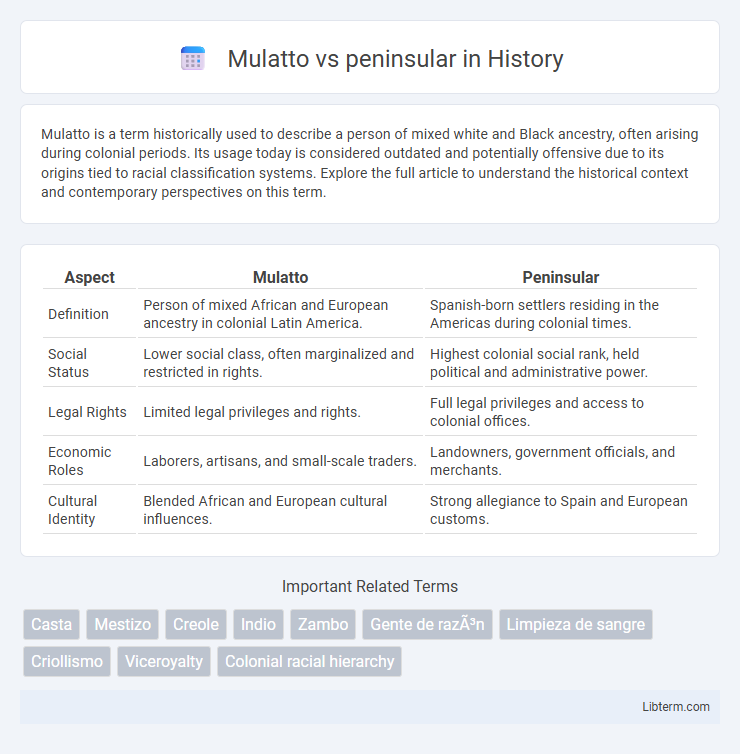Mulatto is a term historically used to describe a person of mixed white and Black ancestry, often arising during colonial periods. Its usage today is considered outdated and potentially offensive due to its origins tied to racial classification systems. Explore the full article to understand the historical context and contemporary perspectives on this term.
Table of Comparison
| Aspect | Mulatto | Peninsular |
|---|---|---|
| Definition | Person of mixed African and European ancestry in colonial Latin America. | Spanish-born settlers residing in the Americas during colonial times. |
| Social Status | Lower social class, often marginalized and restricted in rights. | Highest colonial social rank, held political and administrative power. |
| Legal Rights | Limited legal privileges and rights. | Full legal privileges and access to colonial offices. |
| Economic Roles | Laborers, artisans, and small-scale traders. | Landowners, government officials, and merchants. |
| Cultural Identity | Blended African and European cultural influences. | Strong allegiance to Spain and European customs. |
Understanding Mulatto and Peninsular: Definitions
Mulatto refers to a person of mixed African and European ancestry, particularly in colonial Latin American societies, often occupying a middle social class status. Peninsular denotes a Spaniard born in Spain who migrated to the Americas, typically holding higher social, political, and economic privileges in colonial hierarchies. Understanding Mulatto and Peninsular distinctions is crucial for analyzing racial and class structures during Spanish colonial rule.
Historical Context of Racial Terms
Mulatto referred to individuals of mixed African and European descent during the colonial period, often occupying an intermediate social status in Latin American societies. Peninsular described Spaniards born in Spain who held the highest social and political positions in colonial administrations, distinguishing them from Creoles born in the Americas. These terms were integral to the rigid caste system, reflecting the racial and social hierarchies imposed by Spanish colonial rule.
Origins and Etymology
The term "Mulatto" originates from the Spanish and Portuguese word "mulato," historically used to describe individuals of mixed African and European ancestry, specifically during the colonial era in Latin America. "Peninsular" refers to Spaniards born on the Iberian Peninsula, distinguishing them from those born in the colonies, known as Creoles, with the term rooted in the Latin word "peninsula," meaning "almost an island." These distinctions emerged in the context of racial and social hierarchies during Spanish colonial rule, reflecting complex identities shaped by geography and ancestry.
Social Hierarchies in Colonial Latin America
Mulattos, individuals of mixed African and European descent, occupied a lower social status compared to Peninsulars, who were Spanish-born elites in Colonial Latin America. Peninsulars held the highest social, political, and economic power as they were appointed to key administrative and ecclesiastical positions by the Spanish Crown. The rigid caste system prioritized racial purity, marginalizing Mulattos and restricting their access to elite privileges, land ownership, and political influence.
Mulatto Identity: Heritage and Culture
Mulatto identity reflects a rich heritage rooted in the blending of African and European ancestries, often embodying a unique cultural fusion that includes language, religion, and social customs. Unlike Peninsulares, who were Spanish-born elites in colonial Latin America with full political and economic privileges, Mulattos occupied a distinct social status that highlighted their mixed-race heritage. This identity shaped diverse cultural expressions in music, cuisine, and community traditions, underscoring the complex interplay of race, heritage, and societal roles in colonial and post-colonial contexts.
Peninsular Status: Links to Spain
Peninsulares were Spanish-born colonists occupying the highest social and political positions in colonial Latin America, directly linked to Spain through birth and loyalty to the Spanish Crown. Their status granted them exclusive access to top government roles, major land ownership, and influential positions in the Catholic Church, reinforcing their dominance over mixed-race groups such as mulattos. This direct connection to Spain ensured peninsulares maintained superiority in wealth, power, and social prestige compared to locally born Creoles and mixed-race populations.
Legal Rights and Social Mobility
Mulattos faced significant legal restrictions compared to Peninsulares, who held full citizenship rights and access to colonial offices. Peninsulares enjoyed privileges in property ownership, legal representation, and political influence, while Mulattos were often subject to discriminatory laws limiting their social mobility. The rigid caste system entrenched these disparities, making legal rights and upward movement virtually inaccessible for Mulattos within Spanish colonial society.
Representation in Literature and Art
Mulatto characters in literature and art often symbolize the complex intersections of race and identity, embodying themes of hybridity and social marginalization. Peninsular figures, representing European-born Spaniards, typically convey themes of power, authority, and colonial dominance within narratives and visual works. The contrasting portrayals highlight entrenched racial hierarchies and cultural tensions in colonial Latin American societies.
Modern Perspectives on Historical Classifications
Modern perspectives on historical classifications such as Mulatto and Peninsular emphasize the complex social hierarchies shaped by colonialism and racial mixing in Latin America. Contemporary scholarship critiques these terms for their role in enforcing rigid racial categories that disregarded cultural identities and blurred the lines between ethnicity and social status. Current debates highlight the need to understand these classifications within their specific historical contexts while recognizing their lasting impacts on racial and social dynamics today.
Lasting Impact on Contemporary Society
The longstanding social hierarchy between Mulattos and Peninsulares has profoundly shaped contemporary racial and class dynamics in Latin America. Peninsulares, as Spanish-born elites, historically controlled political power and economic resources, while Mulattos--of mixed African and European descent--faced systemic marginalization, influencing persistent inequalities today. This legacy is evident in ongoing debates about racial identity, social mobility, and representation within modern Latin American societies.
Mulatto Infographic

 libterm.com
libterm.com